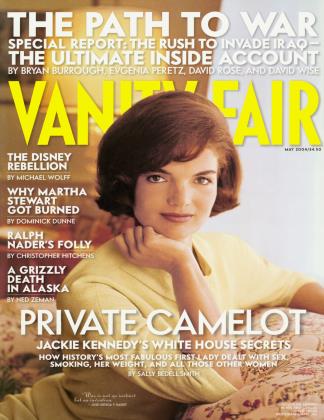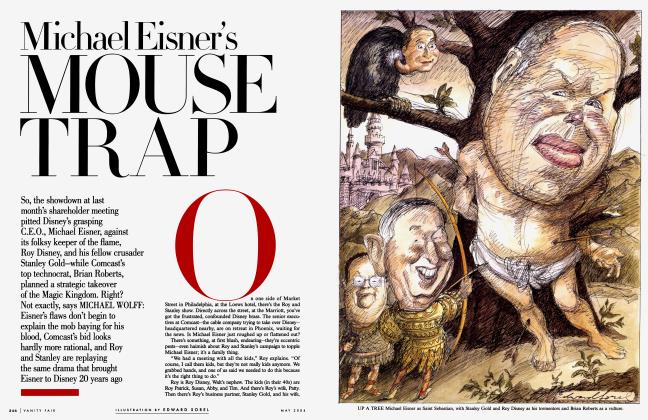Sign In to Your Account
Subscribers have complete access to the archive.
Sign In Not a Subscriber?Join NowCONTRIBUTORS
When he started work on this issue's massive investigation of the path to war in Iraq, special correspondent BRYAN BURROUGH had the same question many Americans did: "How did a war effort with so many reasons to justify it end up predicated on just one?" At the time of the invasion, Burrough found himself deeply conflicted, supporting the mission's wider goal but questioning its execution. "It comes down to goodwill for the wrong reasons. The administration had ample reasons to take Saddam out, but what angers me is we justified it for the wrong one: weapons of mass destruction." Burrough's new book, Public Enemies: America's Greatest Crime Wave and the Birth of the F.B.I., 1933-1934, will be published in July by Penguin Press.
The assignment to unravel what went wrong in the pre-Iraq-war negotiations at the U.N. at first seemed dizzyingly complex to contributing editor EVGENIA PERETZ. But, after interviewing dozens of diplomats, members of inspection teams, and other U.N. officials, Peretz came to see that the root cause of the failure was simple: the Bush administration's contempt for the U.N. as an organization. "Aside from the issue of having to jam the negotiating schedule into the immovable timetable of U.S. Central Command, there was a problem of style," she says. "Whether it was dealing with inspectors or foreign heads of state, this administration displayed its trademark swagger. In every single instance, it backfired."
Contributing editor DAVID ROSE made many fascinating discoveries while reporting on the run-up to war in Iraq for this issue, but perhaps the most disturbing involved Tony Blair. "Blair is the reason America and Britain got boxed into the W.M.D. issue—if Iraq had them, he would have gotten away with it," Rose says. "The tragedy is that the people who most wanted the war in Iraq were motivated by honest reasons." A proud father of four, including newborn Daniel, Rose believes that his children will be learning more about these events for years to come. "This is a first draft of history," he says. "It was an epochal world event that will cast a long shadow."
FOR DETAILS, SEE CREDITS PAGE
CONTINUED ON PAGE 66
CONTINUED FROM PAGE 64
DAVID WISE. America's leading writer on intelligence and espionage, is the author of more than a dozen books on the subject. His most recent work, Spy, about former F.B.I. agent Robert Hanssen, was described by The New York Times as the "most authoritative" study of Moscow's mole. This month, Wise brings his intelligence expertise to V.F., collaborating with Bryan Burrough, Evgenia Peretz, and David Rose on a detailed account of America's path to war with Iraq. "This administration was not eager to talk about the C.I.A.'s prediction that W.M.D. would be found in Iraq, or how the White House inflated the intelligence to lead the country into war," says Wise. "But I always like a challenge."
As the researcher for this month's "Path to War"— V.F's largest special report ever, with its quadruple byline and 32-page layout—JOHN ORTVED performed a herculean task. "Because the amount of information available was so vast, the greatest challenge was filtering it down, supplying the writers with the most concise information," he says. Ortved, who grew up in Toronto, recently graduated from McGill University in Montreal, where he studied economics and English literature and wrote a weekly column for the school's newspaper. He has brought his international perspective and economic expertise to this and numerous other V.F. stories.
Access was, surprisingly enough, not a problem for V.F.'s newest columnist, MICHAEL WOLFF, as he went about writing his first piece for the magazineon Michael Eisner and the shareholders' revolt at the Walt Disney Company. "I've been one of Michael Eisner's harshest critics," says Wolff, who admits to "pulling him apart" in his recent book, Autumn of the Moguls (HarperCollins). "It seems mind-boggling that he would still allow me to interview him for this article." The author of Bum Rate, an account of the rise and fall of his own Internet business, Wolff wrote a column on media culture in New York magazine for almost six years and won a National Magazine Award in 2002.
CONTINUED ON PAGE 68
CONTINUED FROM PAGE 66
Since becoming a V.F. contributing editor in 1996, SALLY BEDELL SMITH has profiled such international luminaries as Stavros Niarchos, Gianni Agnelli, and Sir James Goldsmith. In this issue's excerpt from Grace and Power: The Private World of the Kennedy White House, published this month by Random House, Smith provides new insights into the Kennedys' marriage. "Jackie was quite conscious of creating a court," Smith says, "and the Camelot metaphor was the most vivid evidence of that." Smith says her book, which comes 10 years after Jackie's death, "offers a new appreciation of her as a woman and as a First Lady."
Five years ago, Liz Smith gave restaurant connoisseur PETER ELLIOT (right), who has been dishing up reviews on the Bloomberg multi-media-and-radio network for a decade, the idea to co-write a book with Le Cirque 2000 owner SIRIO MACCIONI. Now Sirio: The Story of My Life and Le Cirque is about to be published by John Wiley & Sons. "I wanted readers to see that Sirio's story is only a little bit about the glamour—it's mostly about a great ItalianAmerican who came from nowhere and survived," Elliot says. Maccioni, meanwhile, says collaborating with Elliot was a pleasure: "I was afraid Mr. Elliot was getting to know me too well. Like all writers he is a pain in the neck, but I decided to go ahead anyway."
Before exploring conspiracy theories for an article in this issue (see page 138), writer RICH COHEN had always wondered why such theories exist and what links them together. Starting out, he says, he "was suspicious but willing to learn. You have to be skeptical or you'll believe everything you hear." What surprised him the most, in the end, was "how big the story of conspiracy theories is, how they're all connected to one theory created thousands of years ago. It's like the twilight zone." Cohen's fourth book, Machers & Rockers: Chess Records and the Business of Rock & Roll, will be published by Norton in the fall.
While reporting on the gruesome deaths of Timothy Treadwell and Amie Huguenard, who were killed by a grizzly bear last year, contributing editor NED ZEMAN was struck by Treadwell's similarities to an earlier subject, wildlife photographer Bruno Zehnder, who froze to death among the penguins he loved. "They both kept going to farther and farther ends of the earth in search of a meaningful connection," Zeman says, "and they put most of their stock in creatures." This fall, a feature film about Zehnder (written by Zeman and Daniel Barnz) begins filming in Antarctica.
FOR DETAILS, SEE CREDITS PAGE
 View Full Issue
View Full Issue






Subscribers have complete access to the archive.
Sign In Not a Subscriber?Join Now